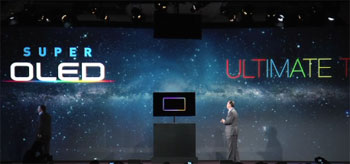It’s been over a year since we first saw Samsung teasing us with its stunning OLED TV prototype at CES 2012, with its dazzling visuals and slender profile enough to leave even the most cynical of critics drooling in anticipation.
 |
| Samsung OLED TV to hit shops this August? |
But as attractive as Samsung’s OLED display may be, its remained noticeably absent from production lines, high street stores and living rooms. Samsung originally said that that the plan was for OLED to hit the shops by summer of 2012, only to be beset with manufacturing yield issues that have put the skids on a commercial release.
Samsung has since lost ground to rival LG, which announced back in January that it would begin shipping its own 55-inch 55EM9700 OLED model this month, albeit for a cool £6,300. Meanwhile, Samsung has remained suspiciously quiet with regard to its own plans for a release date, despite once again showcasing the technology with the world’s first curved OLED TV at this year’s CES.
But recent reports suggest that Samsung may finally be gearing up for the release of its own Super-OLED TV at long last. According to a report in HDGuru, Samsung has recently concluded a Southeast Asian forum in Jakarta, Indonesia, where it was revealed that it’s KN55F9500 OLED display model will be priced at whopping £12,000 when it goes on sale in the region this August. The report didn’t make any mention of a UK or US release date, leaving us to ponder if Samsung might only be planning to launch its new OLED in its own backyard for now.
What’s interesting is the price discrepancy between LG’s and Samsung’s OLED models, with the former being almost 50% cheaper than the latter. Part of this can be explained away by the different technology each manufacturer uses, with LG relying on “white” organic light-emitting diodes that incorporate a sandwich of green, red and blue OLED layers underneath green, blue, red and clear filters. Samsung’s KN55F9500 meanwhile, uses straight green, red and blue OLEDs, which it claims produces deeper, richer and brighter colors, and better contrast. Even so, this difference is unlikely to account for Samsung’s OLED flavor costing almost twice as much as its rival’s.
For many analysts, the price difference will only lend weight to the belief that LG is racing ahead of its rival in terms of OLED production efficiency, a theory is given further credence by the fact that LG’s OLED will be shipped a full four months ahead of Samsung’s.
Even so, the prices suggest that neither company has managed to fully overcome the problem of low production yields, but are instead looking to push ahead in spite of these problems in order to get a head start on a market that’s expected to overtake 4K TV and see around 10 million global shipments by 2012 2015. It’s reported that more than 100 customers have already placed an order for LG’s 55EM9700 OLED since it became available to pre-order in January.
Source: HDGuru